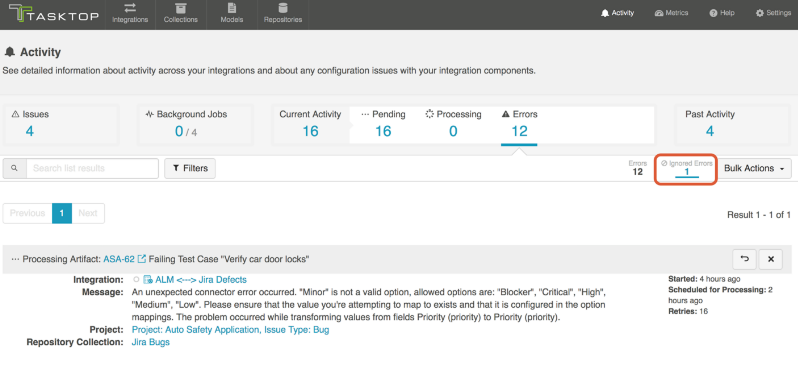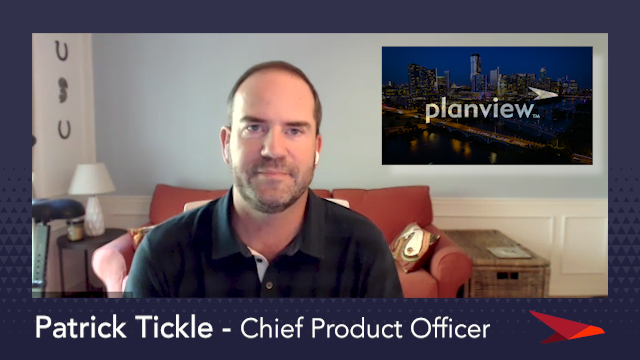
Tasktop Integration Hub 18.3 is available today, introducing the ability to ignore specific errors, receive email notifications for errors and issues, an updated metrics dashboard with model and user ID counts, change detection interval fine-tuning, improved visibility on background jobs, and the new PTC Integrity Lifecycle Manager connector.
Ignore Specific Errors
Tasktop’s Activity screen displays a list of any errors that occurred in your integrations, under the Errors tab. Sometimes, you may decide that a specific error is one you can ignore and don’t need to resolve. You definitely don’t want this error cluttering your error list and affecting the error count.
In version 18.3, we’ve added the ability to ignore certain errors in a given integration. After determining that you can ignore a specific error, you move it to the ‘Ignored Errors’ list. The error will no longer appear in the Errors main list and no longer affect the Error count in the summary banner.
Activities related to ignored errors are not canceled, however, and they will be retried if relevant. If these errors become relevant again, you can access them from the ‘Ignored Errors’ list and stop ignoring them, which will restore them to the main Errors list.
Learn more in our User Guide here.
Email Notifications for Errors and Issues
It’s now possible to receive notifications of errors and issues directly to your Inbox with email notifications. Tasktop admins will receive a digest of all the errors that occurred since the previous email was sent, at an interval you define.
Learn more in our User Guide here.
Models and User Counts Introduced to the Metrics Dashboard
The Metrics Dashboard is where you can see the volumes of artifacts created and updated by your integrations over time. In this new version, we’ve added two additional data points.
First, you can now see the number of artifacts created or updated per model to gain quick insight into what is flowing.
Second, you can now see the number of unique User IDs Tasktop is seeing per integration or repository over time in the cumulative statistics. This data can help convey how many people in your organization are actually benefiting from toolchain integration.
Learn more in our User Guide here.
Change Detection Interval Fine-Tuning
In this new version, the system-wide change detection and full scan intervals can be overwritten for each collection participating in a given integration. This new option allows admins to control the impact of queries on specific repositories. We’ve also set the default full scan interval default to 24 hours.
The change detection interval defines how often Tasktop queries the repository for relevant artifacts that have been modified since the previous query, based on the artifact’s ‘last modified date’.
In full scans, Tasktop queries the repository for every relevant artifact in order to capture changes that don’t cause an update to the artifact’s ‘last modified date’. If this is the case with pertinent changes in one of your collections, you might want to shorten the full scan setting accordingly.
Let’s take the example of an IT organization that has a Jira-to-ALM integration that is also flowing attachments. When a new attachment is added in Jira, the ‘last modified date’ gets updated. However, when an attachment is added to ALM, the ‘last modified date’ does not get updated. Hence, for that specific integration, you may want to shorten the full scan interval for the ALM collection.
Learn more in our User Guide here.
Improved Visibility on Background Jobs
We’ve added a new tab to the Activity screen where Tasktop admins can see the progress of background jobs, for example applying project and domain name changes in ALM, or upgrading to a new Tasktop version.
Learn more in our User Guide here.
New ALM Tool Supported: PTC Integrity Lifecycle Manager
PTC Integrity Lifecycle Manager is an ALM (Application Lifecycle Management) platform that helps teams deliver higher quality, more innovative software and systems with less risk. Business analysts, architects, engineers, developers, quality managers, testers, and other stakeholders use PTC Integrity Lifecycle Manager to collaborate and control the product development lifecycle.
Synchronizing Requirements
Software delivery organizations whose developers use PTC Integrity often express the need to synchronize requirements from a requirements management tool into PTC Integrity, where the requirements can be broken down and worked on by developers. In addition, they often want to flow defects logged in PTC Integrity to the requirements management tool, so the product managers and business analysts have visibility on them.
Other organizations use PTC Integrity for requirements management and want to flow those requirements to another Agile planning tool – for developer implementation, or to a test management tool – where they can be used to design high quality test coverage.
With Tasktop Integration Hub, those integration patterns and many more are now available to PTC Integrity Lifecycle Manager users.
Tasktop synchronizes requirements and defects to and from PTC Integrity and the rest of the software delivery toolchain.
The following demo video demonstrates an integration between Jama, a requirements management tool, and PTC Integrity – used here by developers for Agile planning and defect tracking. This integration serves to improve collaboration between the product team and the developers, eliminate duplicate data entry between systems and improve product quality and traceability.
Learn more in our User Guide here.
Terminology and Graphical Interface Changes
- “Work Item Synchronization + Container Mirroring” integration template has been renamed “Container + Work Item Synchronization”
- Leankit connector has been renamed Planview LeanKit, with updated icon
- VersionOne connector has updated icon











